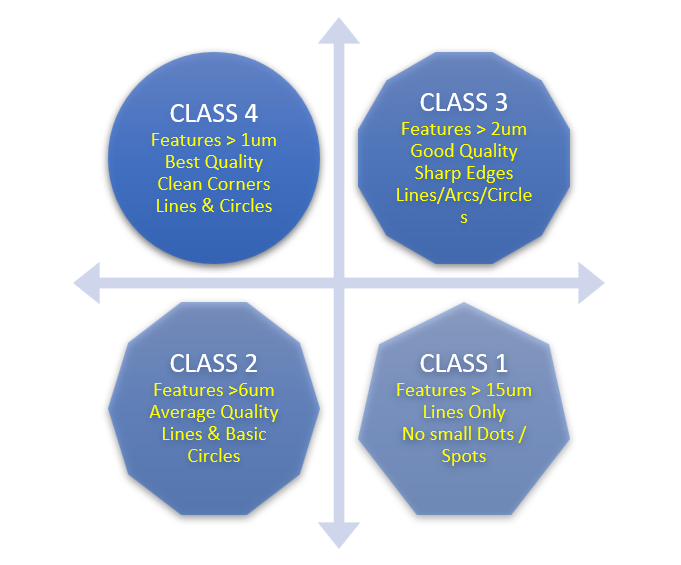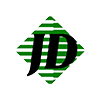Small Format Chrome Resolutions
The following information refers to chrome coated glass plates, upto a maximum of 227mm in size.

CHOOSING RESOLUTIONS
We can write masks at 4 different resolutions, called "classes". The higher the Class, the better the quality. For each increase in Class, there will be a 2x improvement in the following parameters: Addressability, Minimum Line, Edge Roughness, CD Uniformity, and Alignment Accuracy.
Class 1 : This is our lowest resolution. Although this resolution may resolve smaller features, we recommend keeping feature sizes above 15um as corner rounding is considerable. Edge sharpness and definition is acceptable for non-critical design types, although designs with arcs/circles and lines running off 90-degree grid may show pixilation. NO features such as lines / circles / spots / squares below 10 um unless on a 'best effort' basis agreed with our technicians.
Class 2 : Although this resolution may resolve 4um lines, we recommend keeping feature sizes above 6um. This resolution has good line edge qualities with only a small pixilation along the edges. NO features such as circles / spots / squares below 6um unless on a 'best effort' basis previously with our technicians.
Class 3 : This represents our most common resolution for demanding, high-precision photomasks, and offers an excellent price / quality balance. This resolution will resolve down to 2 micron lines, and has very good line edge qualities with no pixilation along edges, and corner rounding is minimal on larger features.
Class 4 : This represents our highest resolution, and is drawn with a 0.5um pixel, and is the best quality that we can offer. This resolution will resolve down to 1 micron lines and has excellent line edge qualities with no pixilation along edges.
FEATURE TOLERANCES
There are two different values that we specify for tolerances. The first is a ‘feature tolerance’, which equates to one specific feature (also known as CD or Critical Dimension). So, if part of your mask design has a 12um channel and this is a critical feature, you can use the table below to work out possible deviations to the channel width, depending upon which resolution you choose. As a rule, the higher the resolution, then the more accurate the individual feature size will be.
All figures above in Microns....
Example, at Class 2 resolution a 10um line would have a tolerance of (0.6 + 0.5) = 0.9, but this
is greater than the maximum deviated amount of 0.8, so end result is Tolerance = +/- 0.8um
DIMENSIONAL TOLERANCES
The second tolerance that customers ask us about is that of overall dimensional tolerances. These refer to the tolerances over a distance greater than 5mm – in layman’s terms, people ask us ‘how accurate will the mask be’ and these guidelines should go somewhere towards providing the tolerances in overall dimensions, depending upon the resolution chosen. Again, it goes without saying that the higher the resolution, then the more accurate the final mask.
*where L is measuring length in MM and the resulting figure is in microns.
All figures above in Microns....
Example, at Class 3 resolution a 100mm line would have a tolerance of (0.6 + 0.4) = +/- 1.0um




